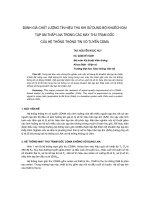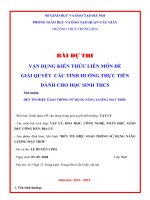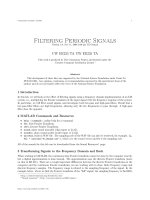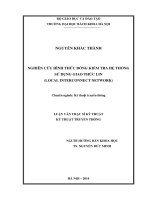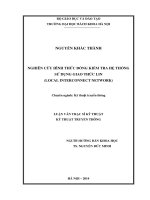thực hành tín hiệu hệ thống sử dụng matlab
Bạn đang xem bản rút gọn của tài liệu. Xem và tải ngay bản đầy đủ của tài liệu tại đây (46.95 KB, 2 trang )
Thực hành Tín hiệu và hệ thống | HQT-FoEEE-PU
Chữa bài tập - Thực hành tuần 3
Ex1: Biểu diễn hàm nhảy bậc dưới dạng liên tục và rời rạc với -5 ≤ t, n ≤5.
%% discrete-time step function, buoc nhay tai vi tri k = 2
n=-5:1:5;
n0=2
du=stepfun(n,n0)
figure()
plot(n,du,'r*','linewidth',2)
title ('discrete-time step function')
xlabel('time n')
ylabel('u[n-2]')
%% Ve tren 1 hinh
figure()
subplot(211)
plot(t,u,'linewidth',2);
axis([-6 6 -0.1 1.1]); % xlim([-6 6]); ylim([-0.1 1.1]);
grid on
subplot(212)
% plot(k,du,'r*','linewidth',2)
stem(k,du,'linewidth',2);
axis([-6 6 -0.1 1.1]);grid on
Ex2: Biểu diễn tín hiệu sau:
x(n) = 2Δ(n + 2) - Δ(n - 4), -5≤ n ≤5
clear;clc;close all;
% x(n)=2d(n+2)-d(n-4), -5<=n<=5
n = [-5:5];
x = 2*impseq(-2,-5,5)-impseq(4,-5,5);
figure()
stem(n,x);
title('Chuoi x(n)=2\delta(n+2)-\delta(n-4)')
xlabel('n'); ylabel('x(n)'); axis([-5,5,-2,3]);
%% y(k)=p4(k+3)+d(k-2), -5<=k<=5
clear;clc;close all;
k=[-10:no-3 no-2:no+2 no+3:10];
p4k=[zeros(1,8+no) ones(1,5) zeros(1,8-no)];
ip1= 3*impseq(2,-10,10);
yk= p4k + 3*impseq(2,-10,10);
figure()
stem(k,yk);
axis([-10 10 -0.1 3.1]); grid on
Thực hành Tín hiệu và hệ thống | HQT-FoEEE-PU
Ex3: Lấy mẫu của tín hiệu x(t) = cos(2πf0t), trong đó f0 = 1000, 0 ≤ t ≤50 sử
dụng các tần số lấy mẫu fs1=10000, fs2=1500. Vẽ tín hiệu rời rạc thu được. Nhận
xét về các tín hiệu rời rạc thu được.
clear;clc;close all;
f0=1000;
%Frequency of sin
fs1=10000; %Sampling Frequency Fs>2F0
fs2=1500;
%Sampling Frequency Fs<2F0
% T0= 1/f0;
% T1= 1/fs1;
% T2= 1/fs2;
n=0:1:50;
x1=cos(2*pi*f0*n/fs1);
x2=cos(2*pi*f0*n/fs2);
%%
figure()
subplot(2,1,1)
plot(n,x1)
subplot(2,1,2)
hold on
plot(n,x1)
% thamsodothi;
stem(n,x1,'r')
plot(n,x2,'-bd')
legend('Original function','Sampling With
Fs>2F0','Sampling With Fs<2F0');
Ex4: Sử dụng Matlab để ghi âm tín hiệu và lưu vào máy tính. Gợi ý, sử dụng các
hàm audiorecorder, recordblocking, getaudiodata, audiowrite.
clear;clc;close all
% Record your voice for 10 seconds.
fs=1000;
recObj = audiorecorder(fs,16,1);
disp('Start speaking.')
recordblocking(recObj, 10);
disp('End of Recording.');
% Play back the recording.
play(recObj);
% Store data in double-precision array.
myRecording = getaudiodata(recObj);
% Plot the waveform.
plot(myRecording)

